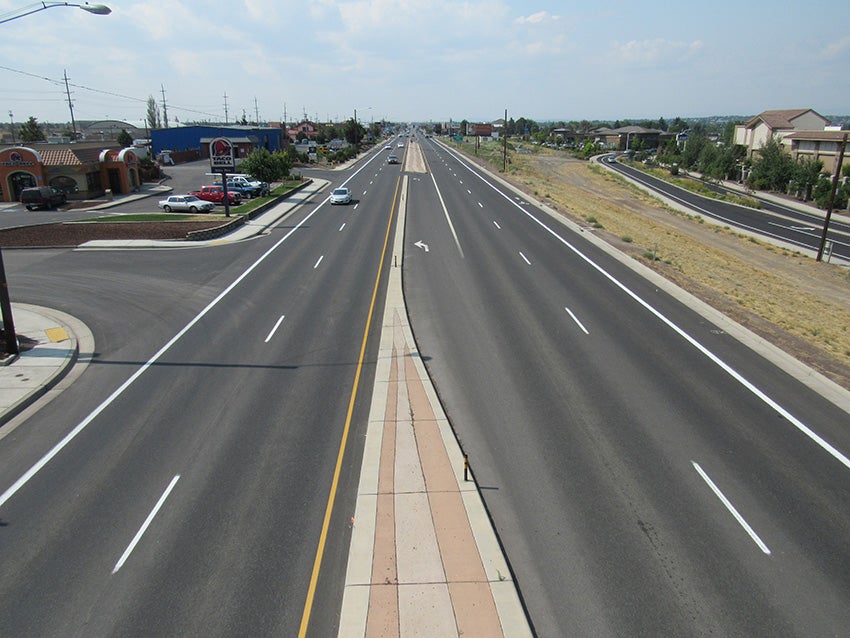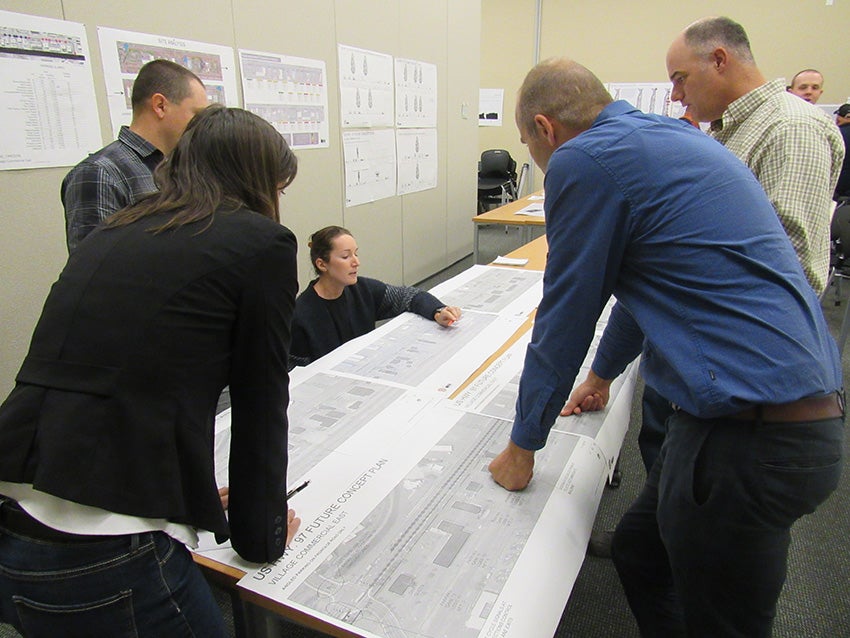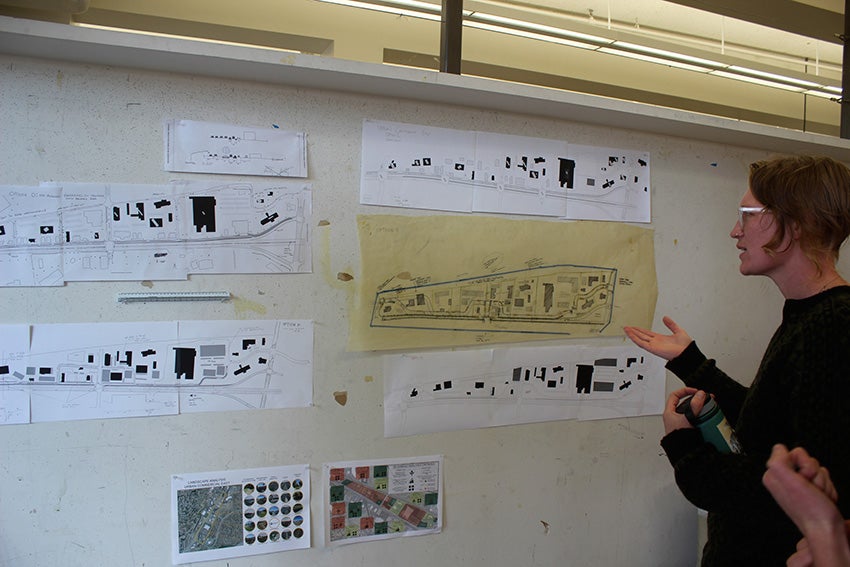“Multi-way boulevard” may sound like a free-for-all, but for students in Rob Ribe’s Land Planning and Design studio this fall, it’s an extraordinary opportunity to fix an accelerating problem.
A problem involving too many cars and trucks in a four-mile section of US Highway 97 through Redmond, Oregon. A problem of maintaining access to businesses and reducing accidents.
The students are enrolled in one of several classes offered through the UO’s Sustainable Cities Year Program (SCYP), an annual partnership with UO and a city in Oregon. In a typical year, 400 students from a dozen disciplines devote 40,000 hours to helping the partner city attain its sustainability goals. The program encourages innovative and challenging courses.

Above: Professor Rob Ribe (right) considers students’ analysis of transportation challenges in Redmond with (clockwise starting at Ribe’s left), undergraduate student Yunfeng Yao, ODOT representative Joel McCarroll, undergraduate student Colin Roberts, undergraduate student Chase Gonty, and graduate student Kayla Byrne. Photo courtesy Jeff Krueger.
In Ribe’s studio—offered by the Department of Landscape Architecture—that translates to finding ways Redmond can move vehicles safely and efficiently through its busy commercial district. Because the proposals are for a class—so may or may not be implemented—students can skitter out to the edge of their idea banks.
That allows the City of Redmond and the Oregon Department of Transportation to consider more realistic and speculative plans for the multi-way boulevard, a rare form of street design in the United States.
Ribe says Redmond Mayor George Endicott told him that, as far as student designs go, nothing is out of bounds. “He said he wants to see what we come up with,” says Ribe, a Fellow in the American Society of Landscape Architects. “He wouldn’t say that to a consultant that he was paying a quarter-million dollars to. Consulting firms typically can’t be as speculative as students.”
The City of Redmond and ODOT turned to SCYP for solutions to handle increased traffic, reduce accidents, and address business visibility concerns on the Highway 97 corridor through Redmond. Students would offer fresh perspectives, they realized.
“The beauty of students having a carte blanche approach to the project is that they’re going to be pushing ideas and concepts that we haven’t thought about,” says Heather Richards, Redmond’s community development director.
SCYP Program Manager Megan Banks says the typical approach to city planning with a professional consultant is reversed in the SCYP approach.
“Typically, you’d tell the consultant the outcome you’re looking for. This flips that on its head,” Banks says. “A student can question the initial way that the client is even thinking about the problem.”

Above: Highway 97 is important both aesthetically and practically to Redmond’s image. “It’s a critical commercial corridor that serves as many visitors’ first impression of the city,” says Heather Richards, Redmond’s community development director. “Right now it’s sort of a disinvested corridor without a lot of presence, sense of place, or uniqueness that says anything about Redmond itself. It could be Anywhere, U.S.A.” Photo courtesy Jeff Krueger.
Richards stresses the importance of Highway 97, both aesthetically and practically, to the city’s image.
“It’s a critical commercial corridor that serves as many visitors’ first impression of the city,” she says. “Right now it’s sort of a disinvested corridor without a lot of presence, sense of place, or uniqueness that says anything about Redmond itself. It could be Anywhere, U.S.A.”
The multi-way boulevard would differentiate the corridor by providing a central passageway to streamline through traffic while allowing access to businesses via one-way frontage roads without making left-turns out into the highway—the cause of many vehicle accidents.
It would also include more intersections, enable safer business access, and augment bicycle transportation, says studio co-instructor Jeff Krueger, a landscape architect, planner, and ecologist with Jeff Krueger Environments LLC.
“Ultimately, one of its main benefits is you eliminate all the curb cuts of businesses going directly onto the state highway,” says Krueger, MLA ’92.
Factoring in all those concerns complicates the challenge, which Ribe and Krueger embraced when shaping their studio.
“This class is intentionally as complex as possible,” Ribe says. “The intent is to completely snow the students so they understand just how complex planning problems actually are.”
That hasn’t caused students to back away from the task.
“Some student teams are exploring radical new design approaches to solve safety problems, which nobody has ever designed anywhere in the world,” says Ribe. “If the city were to adopt some of those ideas, I’m not sure if we could call it a multi-way boulevard. We’d have to give it a new name.”
Kelly Stoecklein, a landscape architecture graduate student, has taken intensive studios in planning before, but this is her first experience with highway design.
“We’re taking each intersection and trying to fulfill what the City of Redmond and business owners want to achieve,” she says. “You get to think about circulation, about patterns, about where people want to go and how you can help facilitate that.”
The main challenge for the students is the site's physical limitations, says Michael Duncan, an ODOT associate planner.
"There’s a canal on one side and a railroad track on the other. Somehow they’ll have to finesse the complexities of a multi-way boulevard that can accommodate through traffic and local access into a highly constrained environment. That’s really been one of the major issues all along. If the solution were easy, we’d already have the answer. "
The studio has taken several trips to Redmond for students to study their portion of the project and meet with city councilors, business owners, and city planning staff.
"The business owners are already on edge and primed to be anxious about change in the area,” says Stoecklein. “It's all about how we communicate our proposed designs to them."

Above: Graduate student Kelly Stoecklein (kneeling) points out features of her plan for a commercial area in Redmond with (clockwise, starting with woman in dark jacket) undergraduate Casey Howard, graduate student Matthew Jorgensen, ODOT’s Joel McCarroll (in checked shirt), and graduate student Krisztian Megyeri. Photo courtesy Jeff Krueger.
“You have to be accommodating and give reasoning why your design would be good for them,” adds Dominic Giulietti, an undergraduate landscape architecture student.
ODOT's Duncan says stakeholders are "looking for innovation. It may sound cliché, but the ability to think outside the box on this project is a huge. We’ve been at this for a while, and with those years of stakeholder meetings comes certain expectations and more clearly defined guidance, which is great—we need that, and stakeholder input is critical. I think we’re all looking forward to some fresh perspective that isn’t bound by a pre-existing filter. "
Duncan notes that a relatively recent design charrette "allowed a number of stakeholders to lend their perspective and watch their values and priorities come alive on paper. This was an important milestone. This was the first time many of the stakeholders were able to coalesce around a similar vision. The work that will come from the SCYP partnership will be a refinement of that effort and represents the next step in ground-truthing the charrette concept of a multi-way boulevard."
Students are also studying ways to accommodate the arid climate and wide temperature swings of Redmond’s climate, which complicates plant choices.
The six-credit studio marks the continuation of the partnership between SCYP and the City of Redmond, which began in spring 2015 with a bicycle transportation class taught by Planning, Public Policy, and Management Professor Marc Schlossberg.
“Part of the value of SCYP is we do cross-campus [recruitment], connecting different city projects with the UO’s diverse skill sets,” says Banks. “For all the projects, Redmond has or will embrace these project outcomes as meaningful for their community.”
Adds Duncan, "the work done through this partnership will feed directly into the kick-off of a multi-year project to address issues around safety, access, construction phasing, engineering, and the preliminary design of Redmond’s South Corridor."

Above: Kate van Holst, landscape architecture graduate student, discusses results of her landscape and business analysis of her SCYP project in Redmond. Photo by Emerson Malone.
